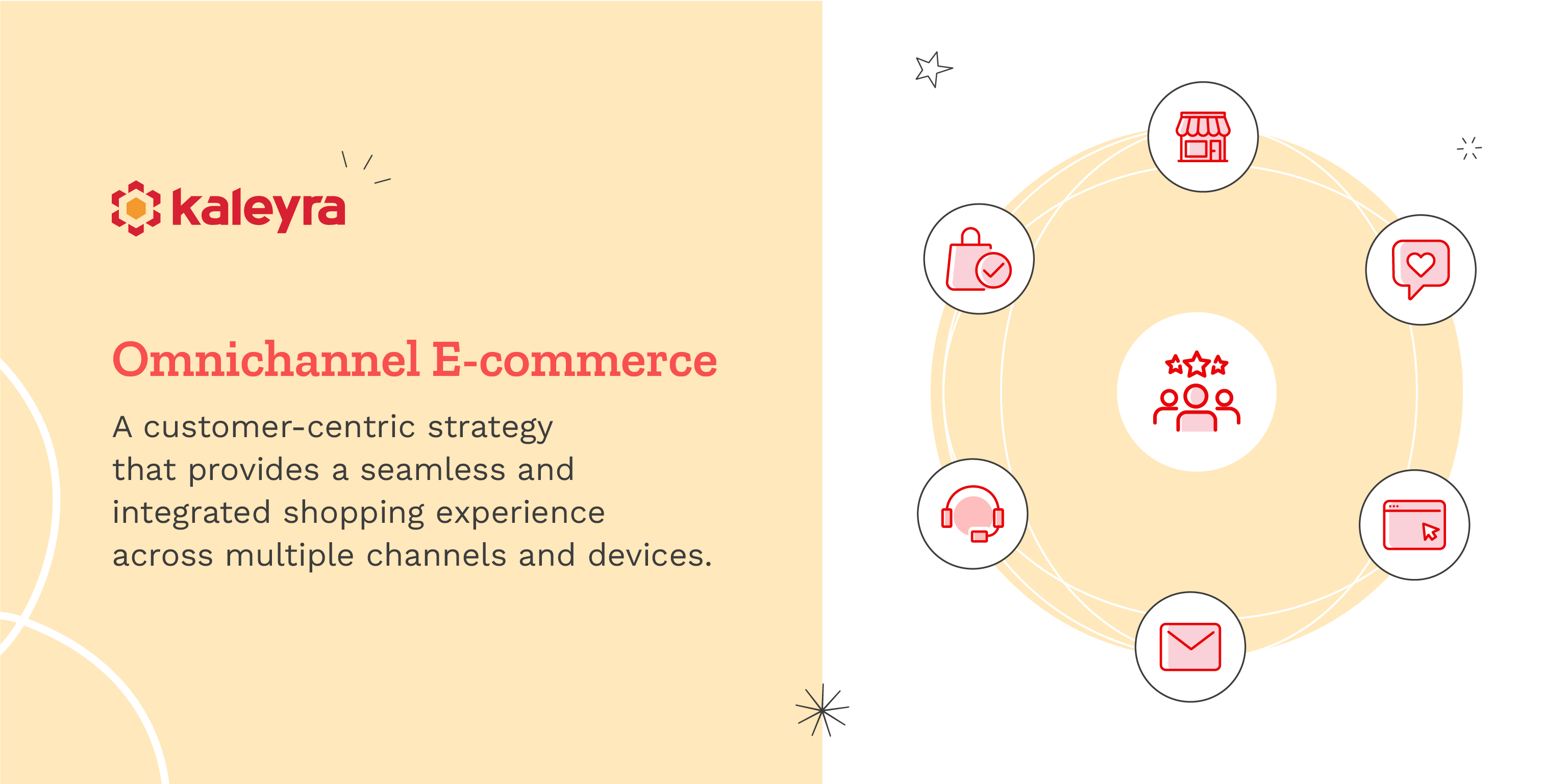6 min read
Unlock Impactful Shopping Experiences with Omnichannel Ecommerce Strategy

E-commerce has experienced exponential growth over the past few years and emerged as an integral component of the global retail landscape. Studies show that e-commerce will facilitate 95% of purchases by 2040. Selling online presents retailers with an unparalleled opportunity to tap into international markets that were previously inaccessible or difficult to penetrate through traditional brick-and-mortar stores alone. However, simply having an online presence is no longer enough. Today’s discerning digital consumers seek personalized and consistent experiences across all touchpoints. This growing expectation has resulted in the widespread adoption of omnichannel ecommerce strategies by retailers worldwide.
What is Omnichannel Ecommerce?
Omnichannel e-commerce is a holistic approach integrating multiple channels to create a unified customer experience. By leveraging omnichannel, retailers can effectively bridge the divide between the digital and physical worlds, offering seamless customer engagement across multiple platforms.
Over three-quarters of customers use two or more channels to explore, research, and purchase products. Customers nowadays engage with brands on desktop and mobile sites, email, social media, online marketplaces, mobile apps, and brick-and-mortar stores. Omnichannel e-commerce is a customer-centric strategy that allows customers to effortlessly transition between channels and devices while enjoying a cohesive shopping journey.
Evolving Shopping Behaviors
Here are a few statistics that illustrate how the digital revolution is reshaping shopping behaviors.
1. Mobile commerce is estimated to account for 42.9% of e-commerce sales in 2024. – Business Insider.
2. A staggering 92 percent of individuals who experimented with online shopping in 2019 have continued the shopping behavior. – McKinsey.
3. Six in 10 internet users begin shopping on one device but continue their journey or complete a purchase on a different one. – Google.
4. Smartphones account for 66% of online orders. – Statista.
5. 80% of B2B companies consider their e-commerce channel to be of the same or higher standard as other channels. – McKinsey.

Benefits of Omnichannel for Ecommerce
Here are the top benefits of an omnichannel strategy –
Impactful Customer Experience
Even when customers switch between channels and devices, they can pick up conversations and tasks from where they left off, resulting in a consistent brand experience. For example, a customer who bought an item online can effortlessly return or exchange it in a store. This demonstrates the convenience offered by omnichannel, where the online and offline experiences are integrated for the customer’s benefit.
Boost in Sales
Omnichannel experiences reduce friction along the path to purchase, improving sales. For example, a customer who visits a store to explore laptop options goes to the desktop website and adds it to the cart. They can go on to complete the purchase from a WhatsApp back-in-stock notification on their phones.
Maximize Customer Lifetime Value
Omnichannel customer engagement cultivates stronger, more meaningful relationships, increasing lifetime value. Customers are more likely to return and continue their patronage when they find brand interactions effortless. Moreover, satisfied customers will likely become brand advocates, driving business growth.
Gain a Deeper Understanding of the Customer
Omnichannel approach lets you gain strategic insights into customer behavior data such as purchase history and browsing patterns. A unified view of the customer can inform more effective marketing strategies and product development decisions.
How to Craft a Successful Omnichannel Ecommerce Strategy?
Here are a few steps to get your omnichannel strategy right
1. Outline Clear Business Objectives
Establish well-defined objectives that serve as the guiding principles for your omnichannel strategy. For example, your desired business outcome may be an uptick in sales and customer retention or expanding market reach and enhancing brand visibility. By setting clear goals, you can ensure a focused and purposeful approach to your omnichannel strategy.
2. Define Your Brand Identity
Your brand identity should remain consistent and recognizable across all channels to give every customer a cohesive brand experience. Consistency in branding helps reinforce your unique value proposition and sets you apart from competitors. Make sure all your teams are aligned on your brand values, voice, and messaging.
3. Select the Right Tools and Platform
Identify the customer engagement platform best suited to your business needs. Implement the right tools to facilitate seamless data flow across all channels. Pick reliable tools and communication providers that value innovation and data security.
4. Optimize for Mobile
With mobile adoption skyrocketing, optimizing your e-commerce experience for mobile has become imperative. Ensure your website, applications, and all digital touchpoints are mobile-friendly. Provide an intuitive user experience on smaller screens by optimizing load times and ensuring compatibility across various mobile platforms.
5. Unify Data and Systems
By integrating business systems, you can get a better understanding of your customers. Leveraging consolidated data from various sources helps you gain a centralized view of customer profiles, preferences, and purchasing patterns.
EBOOK
Elevating Customer Experiences with CPaaS
Learn how to unlock the potential of CPaaS for memorable customer experiences

6. Choose the Right Communication Channels
Identify the channels your target audience loves and is most active on. Tailor your digital presence accordingly and engage on channels that resonate most with them.
7. Design a Seamless Customer Journey
Map out the entire customer journey to ensure a frictionless experience at every stage. Create automated workflows to engage customers across the various touchpoints, from initial awareness and consideration to purchase and post-purchase support.
8. Prioritize Personalization
Leverage the wealth of data from the omnichannel platform and tools to deliver personalized recommendations and communication experiences for each customer. Personalization enhances engagement and fosters loyalty. Use the power of AI and Machine Learning to analyze customer data and customize your engagement strategy to each customer’s unique interests and preferences.
9. Deliver Exceptional Customer Service
Offer multiple channels for customer service, such as SMS, WhatsApp, Video, Voice, phone, email, live chat, chatbots, and social media, to ensure that customers can quickly reach out for assistance or inquiries. Ensure prompt and accurate responses and empower your agents with the necessary tools and training to provide top-notch support across all channels.
10. Monitor and Adapt
Implement robust monitoring and analytics processes to evaluate the performance of your omnichannel strategy. Analyze metrics such as click rates, conversion rates, and customer satisfaction scores across channels to identify areas for improvement. Gather customer feedback through surveys and refine your strategy based on these insights.
Adopting an omnichannel e-commerce strategy is critical for businesses seeking to thrive in this hypercompetitive world. By seamlessly integrating all the online and offline channels, businesses can elevate customer experiences, foster loyalty, and drive revenue growth.

Kalaivani Narayanan
Content Specialist
Supercharge Your Communication!
Get in touch with our experts who strive hard to bring the very best in cloud communications technology to you.

